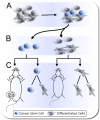Developing ovarian cancer stem cell models: laying the pipeline from discovery to clinical intervention
- PMID: 25495823
- PMCID: PMC4295405
- DOI: 10.1186/1476-4598-13-262
Developing ovarian cancer stem cell models: laying the pipeline from discovery to clinical intervention
Abstract
Despite decades of research, ovarian cancer is still associated with unacceptably high mortality rates, which must be addressed by novel therapeutic approaches. One avenue through which this may be achieved is targeting of tumor-initiating 'Cancer Stem Cells' (CSCs). CSCs are sufficient to generate primary and recurrent disease through extensive rounds of asymmetric division, which maintain the CSC pool while producing the tissues that form the bulk of the tumor. CSCs thrive in the harsh tumor niche, are generally refractory to therapeutic intervention and closely-linked to the Epithelial-Mesenchymal Transition process, which facilitates invasion and metastasis. While it is well-accepted that CSC-targeting must be assessed as a novel therapeutic avenue, few ovarian CSC models have been developed due to perceived and actual difficulties associated with the process of 'CSC Discovery'. In this article we review contemporary approaches to CSC Discovery and argue that this process should start with an understanding of the specific challenges associated with clinical intervention, laying the pipeline backwards towards CSC Discovery. Such an approach would expedite the bridging of the gap between laboratory isolation and clinical targeting of ovarian CSCs.
Figures





References
-
- Kleinsmith LJ, Pierce GB. Multipotentiality of single embryonal carcinoma cells. Cancer Res. 1964;24:1544–1551. - PubMed
Publication types
MeSH terms
LinkOut - more resources
Full Text Sources
Other Literature Sources
Medical
Miscellaneous

